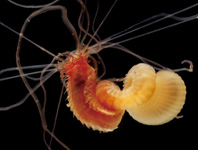Abstract
A new species of lanternshark, Etmopterus samadiae (Squaliformes: Etmopteridae), is described from off northern Papua New Guinea, in the western Central Pacific Ocean. The new species resembles other members of the “Etmopterus lucifer” clade in having linear rows of dermal denticles and most closely resembles E. brachyurus from the western North Pacific. The new species occurs along insular slopes between 340 and 785 m depth. The new species can be distinguished from other members of the E. lucifer clade by a combination of characteristics, including length of anterior flank branch markings being slightly shorter than its posterior branch, a longer caudal base marking, and irregular and variable number of black, horizontal, dash-like marks on sides of body. Molecular analysis based on the NADH2 marker further supports the distinction of E. samadiae from other members of the E. lucifer clade.
References
Bigelow, H.B. & Schroeder, W.C. (1957) A study of the sharks of the suborder Squaloidea. Bulletin of the Museum of Comparative Zoology, 117, 1–150.
Chan, W.L. (1966) New sharks from the South China Sea. Journal of Zoology (London), 148, 218–237.
https://doi.org/10.1111/j.1469-7998.1966.tb02949.xEbert, D.A., Compagno, L.J.V. & DeVries, M.J. (2011) A new lanternshark (Squaliformes: Etmopteridae: Etmopterus) from southern Africa. Copeia, 2011, 379–384.
https://doi.org/10.1643/CI-09-183Ebert, D.A., Straube, N., Leslie, R.W. & Weigmann, S. (2016) Etmopterus alphus n. sp.: a new lanternshark (Squaliformes: Etmopteridae) from the south-western Indian Ocean. African Journal of Marine Science, 2016, 1–12. [published online]
Fricke, R., Allen, G.R., Andréfouët, S., Chen, W.-J., Hamel, M.A., Laboute, P., Mana, R., Hui, T.H. & Uyeno, D. (2014) Checklist of the marine and estuarine fishes of Madang District, Papua New Guinea, western Pacific Ocean, with 820 new records. Zootaxa, 3834 (1), 1–247.
https://doi.org/10.11646/zootaxa.3832.1.1Jordan, D.S. & Snyder, J.O. (1902) Descriptions of two new species of squaloid sharks from Japan. Proceedings of the United States National Museum, 25 (1279), 79–81.
Kotlyar, A.N. (1990) Dogfish sharks of the genus Etmopterus Rafinesque from the Nazca and Sala y Gómez Submarine Ridges. Trudy Instituta Okeanologii Imeni P.P. Shirshova, 125, 127–147.
Last, P.R. & Stevens, J.D. (2009) Sharks and Rays of Australia. CSIRO Publishing, Melbourne, 644 pp.
Last, P.R., Burgess, G.H. & Séret, B. (2002) Description of six new species of lantern-sharks of the genus Etmopterus (Squaloidea: Etmopteridae) from the Australasian region. Cybium, 26 (3), 203–223.
Naylor, G.J.P., Ryburn, J.A., Ferigo, O. & Lopez, A. (2005) Phylogenetic relationships among the major lineages of modern elasmobranchs. In: Hamlett, W.C. (Ed.), Reproductive Biology and Phylogeny of Chondrichthyes: Sharks, Batoids and Chimaeras. Science Publishers, Enfield, pp. 1–25.
Pante, E., Corbari, L., Thubaut, J., Chan, T.Y., Mana, R., Boisselier, M.C., Bouchet, P. & Samadi, S. (2012) Exploration of the deep-sea fauna of Papua New Guinea. Oceanography and Marine Biology: An Annual Review, 25 (3), 214–225.
https://doi.org/10.5670/oceanog.2012.65Sabaj Pérez, M.H. (Ed.) (2016) Standard symbolic codes for institutional resource collections in herpetology and ichthyology: an Online Reference. Version 4.0 (28 June 2014). American Society of Ichthyologists and Herpetologists, Washington, DC. Available from: http://www.asih.org/ (accessed 26 September 2016)
Samadi, S., Puillandre, N., Pante, E., Boisselier, M.C., Chen, W.J., Corbari, L., Maestrati, P., Mana, R., Thubaut, J., Zuccon, D. & Hourdez, S. (2014) Patchiness of deep-sea communities in Papua New Guinea and potential susceptibility to anthropogenic disturbances illustrated by seep organisms. Marine Ecology, 36 (Supplement 1), 109–132.
Schaaf-DaSilva, J.A. & Ebert, D.A. (2006) Etmopterus burgessi sp. nov., a new species of lanternshark (Squaliformes: Etmopteridae) from Taiwan. Zootaxa, 1373, 53–64.
Smith, H.M. (1912) The squaloid sharks of the Philippine Archipelago, with descriptions of new genera and species. Proceedings of the United States National Museum, 41 (1877), 677–685.
https://doi.org/10.5479/si.00963801.41-1877.677Straube, N., Iglésias, S.P., Sellos, D.Y., Kriwet, J. & Schliewen, U.K. (2010) Molecular phylogeny and node time estimation of bioluminescent lanternsharks (Elasmobranchii: Etmopteridae). Molecular Phylogenetics and Evolution, 56, 905–917.
https://doi.org/10.1016/j.ympev.2010.04.042Whitley, G.P. (1939) Studies in ichthyology. No. 12. Records of the Australian Museum, 20 (4), 264–277.
https://doi.org/10.3853/j.0067-1975.20.1939.576

